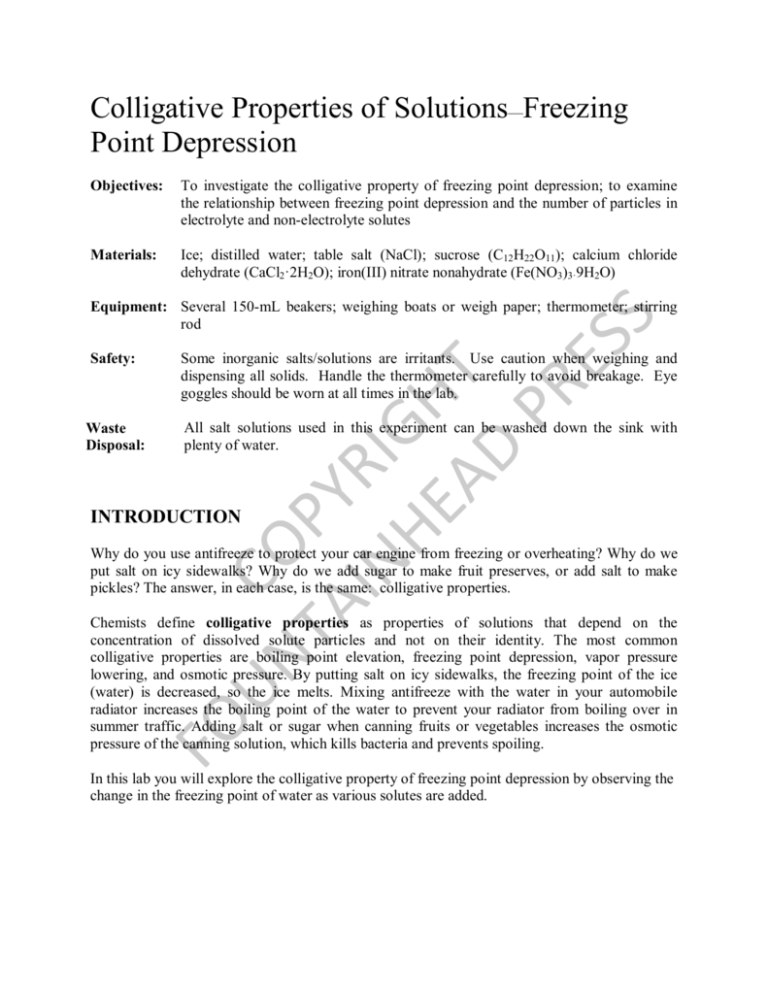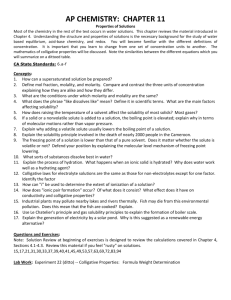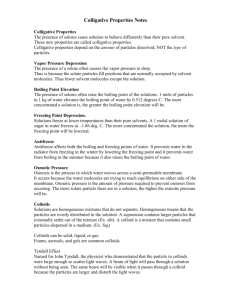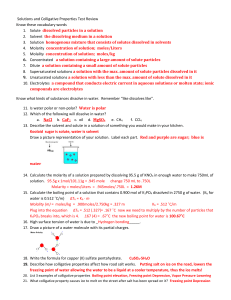Colligative Properties of Solutions Freezing Point
advertisement

Colligative Properties of Solutions—Freezing Point Depression Objectives: To investigate the colligative property of freezing point depression; to examine the relationship between freezing point depression and the number of particles in electrolyte and non-electrolyte solutes Materials: Ice; distilled water; table salt (NaCl); sucrose (C12H22O11); calcium chloride dehydrate (CaCl2·2H2O); iron(III) nitrate nonahydrate (Fe(NO3)3·9H2O) UN CO TA PY IN RIG HE H AD T PR ES S Equipment: Several 150-mL beakers; weighing boats or weigh paper; thermometer; stirring rod Safety: Some inorganic salts/solutions are irritants. Use caution when weighing and dispensing all solids. Handle the thermometer carefully to avoid breakage. Eye goggles should be worn at all times in the lab. Waste Disposal: All salt solutions used in this experiment can be washed down the sink with plenty of water. INTRODUCTION Why do you use antifreeze to protect your car engine from freezing or overheating? Why do we put salt on icy sidewalks? Why do we add sugar to make fruit preserves, or add salt to make pickles? The answer, in each case, is the same: colligative properties. FO Chemists define colligative properties as properties of solutions that depend on the concentration of dissolved solute particles and not on their identity. The most common colligative properties are boiling point elevation, freezing point depression, vapor pressure lowering, and osmotic pressure. By putting salt on icy sidewalks, the freezing point of the ice (water) is decreased, so the ice melts. Mixing antifreeze with the water in your automobile radiator increases the boiling point of the water to prevent your radiator from boiling over in summer traffic. Adding salt or sugar when canning fruits or vegetables increases the osmotic pressure of the canning solution, which kills bacteria and prevents spoiling. In this lab you will explore the colligative property of freezing point depression by observing the change in the freezing point of water as various solutes are added. BACKGROUND Colligative properties of solutions can be estimated using equations that take into account the properties of the solvent and the concentration of dissolved solute particles. The boiling points and freezing points of solvents depend on the intermolecular attractive forces between solvent molecules. Changes in these physical properties occur when the presence of a solute disrupts these interactions. Since the magnitude of intermolecular forces varies between solvents, the properties of the solvent are incorporated into the equations as a constant, k. For freezing point depression and boiling point elevation, these equations are: ∆Tf = kf ·m ∆Tb = kb ·m UN CO TA PY IN RIG HE H AD T PR ES S (1) (2) where ∆Tf and ∆Tb are the changes in the freezing point and boiling point of the solution compared to pure solvent, kf is the freezing point depression constant and kb is the boiling point elevation constant for the solvent, and m is the concentration of solute in units of molality. Molality has units of moles of solute per kilogram of solvent, and is more useful for calculation of this colligative property because, unlike molarity, it is independent of temperature. All solutes, however, are not created equal. Most molecular substances, such as sucrose, will dissolve in water and remain as discrete solvated molecules: C12H22O11 (sucrose) ��������⃗ 𝐻𝐻2 𝑂𝑂 C12H22O11(aq) Some solutes will dissociate, or come apart in solution to form ions. For example, sodium chloride (NaCl or “table salt”) will dissociate into Na+ and Cl-: NaCl(s) ��������⃗ 𝐻𝐻2 𝑂𝑂 Na+(aq) + Cl-(aq) For sodium chloride, and many other salts, the dissociation or ionization process is essentially complete (~100% ionization) in aqueous solutions. Such substances are called strong electrolytes. Other substances, such as acetic acid, are weak electrolytes and will only partially ionize; some of the molecules will dissociate, but the majority remains intact: FO CH3COOH(aq) + H2O(l) ↔ CH3COO-(aq) + H3O+(aq) Since the colligative properties of solution depend on the concentration of dissolved solute particles, an additional factor is included in the colligative property equations to account for the formation of multiple particles as electrolytes dissociate: ∆Tf = i·kf ·m ∆Tb = i·kb·m (3) (4) The additional factor i is called the van ’t Hoff factor and corrects for the formation of multiple solute particles when electrolytes dissolve in solution. The following examples illustrate the dissolution of some strong electrolytes, and their respective i values: NaCl Na+ + Cl- i=2 CaCl2 Ca2+ + 2Cl- i=3 FeCl3 Fe3+ + 3Cl- i=4 Calculate the theoretical boiling point of a solution prepared by dissolving 25.0 g of ethanol (C2H5OH) in 150.0 mL of water. The kb for water is 0.52oC/molal. The kf for water is 1.86oC/molal. Solution: We start by calculating the molality of ethanol in the solution. From the molecular formula we obtain a MW = 46.1 g/mol. Assuming the density of water is 1.00 g/mL, the molality is determined as: UN CO TA PY IN RIG HE H AD T PR ES S Example: � 25.0 𝑔𝑔 �46.1 𝑔𝑔/𝑚𝑚𝑚𝑚𝑚𝑚� 150 𝑔𝑔 𝑤𝑤𝑤𝑤𝑤𝑤𝑤𝑤𝑤𝑤 = 0.542 𝑚𝑚𝑚𝑚𝑚𝑚 = 3.62 𝑚𝑚 0.150 𝑘𝑘𝑘𝑘 Since ethanol is a molecular solute, the value of i = 1. We can now calculate the boiling point elevation as: ∆Tb = i·kb·m = (1) ( 0.52 oC/m) (3.62 m) = 1.88oC FO Since the normal boiling point of water is 100.0oC, the new boiling point of the solution is 100.0 + 1.88 = 101.88 oC. Pre-Lab Questions 1. Define the term colligative property, and list the four common colligative properties of solutions. In terms of UN CO TA PY IN RIG HE H AD T PR ES S 2. (a) Discuss the difference between an electrolyte and a non-electrolyte. colligative properties, why is this difference relevant? (b) How is this difference factored into the calculation of colligative properties? FO 3. a) Calculate the molality of a solution in which 5.00 g of ethanol (C2H5OH) is dissolved in 85.7 g of water. b) What is the freezing point depression for this solution? PROCEDURE 1. Obtain a thermometer, two 150-mL beakers, a plastic weigh boat or weigh paper, a stirring rod, a large beaker of crushed ice, and some distilled water. 2. Prepare an ice bath by filling one of the 150-mL beakers with crushed ice and about 50 mL of distilled water. Stir with a clean stirring rod. Check the temperature of the ice bath with your thermometer. Record this temperature on your Data Sheet. If your thermometer does not read 0.0oC, repeat this step carefully to avoid any possible contamination. If your thermometer still does not read 0.0oC, you may have to correct for an error in subsequent measurements and/or calculations. UN CO TA PY IN RIG HE H AD T PR ES S 3. Weigh out 50.0 g of distilled water in a clean, dry 150-mL beaker. In another beaker, weigh out 50.0 g of ice. While it is not necessary to measure exactly 50.0 g of ice or water, it is important to record the actual mass of water and ice that you obtain. Record these masses on your Data Sheet. Complete Steps 4–8 with each of the solutes listed in Step 4. 4. Weigh out the amount of your solute as indicated below, using a weighing dish or weighing paper. Record the identity and mass of your solute on the Data Sheet. NaCl (table salt) = 2.91 g C12H22O11 (sucrose) = 17.11 g CaCl2·2H2O (calcium chloride dihydrate) = 7.35 g Fe(NO3)3·9H2O (iron(III) nitrate nonahydrate) = 20.19 g Again, you do not need to weigh out these exact masses, but you should record the actual mass obtained on your Data Sheet. 5. Transfer the weighed solid to the beaker containing the 50.0 g of distilled water. Try to transfer all of your solid to the beaker, but do not add any additional water. FO 6. Stir the solution in the beaker with a clean stirring rod until all the solid dissolves. Do not proceed to the next step until all the solid has dissolved. 7. Pour the solution into the beaker containing the ice. Stir gently with the thermometer while monitoring the temperature. Check the temperature about every 30 seconds. When the temperature no longer changes between readings, record this temperature on your Data Sheet. Most of the ice may have melted during this process; as long as some solid ice is still present the solution is, by definition, at its freezing point. 8. Dispose of the solution by flushing it down the sink with plenty of water. Rinse and dry both beakers, your stirring rod, and your thermometer. Repeat steps 4–8 with the next solute. CALCULATIONS 1. Using the solute formulas provided, convert grams of solute to moles of solute. For the hydrated salts be sure to include the waters of hydration in the molar mass. 2. It is reasonable to assume that the total mass of solvent includes the mass of both the water and the ice. If you used exactly 50.0 g of each, then you would have used 100.0 g or 0.100 kg of solvent. Use the actual masses of water and ice recorded on your Data Sheet to calculate the mass of solvent. UN CO TA PY IN RIG HE H AD T PR ES S 3. Calculate the molality of the solution using the moles of solute (from Step 1) and the mass of solvent (from Step 2): 𝑚𝑚𝑚𝑚𝑚𝑚𝑚𝑚𝑚𝑚𝑚𝑚𝑚𝑚𝑚𝑚, 𝑚𝑚 = � 𝑚𝑚𝑚𝑚𝑚𝑚𝑚𝑚𝑚𝑚 𝑜𝑜𝑜𝑜 𝑠𝑠𝑠𝑠𝑠𝑠𝑠𝑠𝑠𝑠𝑠𝑠 𝑚𝑚𝑚𝑚𝑚𝑚𝑚𝑚 𝑜𝑜𝑜𝑜 𝑠𝑠𝑠𝑠𝑠𝑠𝑠𝑠𝑠𝑠𝑠𝑠𝑠𝑠, 𝑘𝑘𝑘𝑘 � 4. Determine the value for the van ’t Hoff factor (i) for your solutes. For molecular solutes the value is i = 1. For ionic solutes, you can determine the value of i by examining the molecular formula. The value will be a small whole number; partial ionization is not expected, and waters of hydration are not included. 5. Calculate the theoretical freezing point depression in oC. The kf for water is 1.86oC/m. 6. Calculate the theoretical freezing point of each solution, and compare it with the experimentally observed freezing point for your solutes. FO 7. Comment on your Data Sheet about the relationship between the observed freezing points and the number of particles in solution (i) for each solute. Data Sheet Freezing point of pure ice water (100.0 g): _______________ oC Solute Mass of solute (g) Mass of ice (g) Mass of water (g) Observed f.p. (OC) Molality (m) i Theoretical f.p. (OC) CaCl2·2H2O C12H22O11 UN CO TA PY IN RIG HE H AD T PR ES S NaCl Fe(NO3)3·9H2O Other? FO Calculations and Conclusions: (Show calculations below) Conclusions? Post-Lab Questions UN CO TA PY IN RIG HE H AD T PR ES S 1. The substance used by homeowners and municipal workers to melt ice on sidewalks and roadways is usually calcium chloride rather than sodium chloride. Discuss two possible reasons for this preference. 2. Calculate the boiling point of a solution prepared by adding 11.5 g naphthalene (C10H8) to 250.0 g of benzene. Naphthalene is a non-electrolyte solute, and benzene is an organic solvent that exhibits a boiling point of 80.10oC, and has a kb = 2.5 oC/m. Show your work. FO 3. Which aqueous solution would exhibit a lower freezing point, 0.35 M K2SO4 or 0.50 M KCl? Explain. 4. Automotive antifreeze is typically a 50:50 mixture (by volume) of water and ethylene glycol. Discuss why this solution is useful for protecting automobile engines from both summer and winter temperature extremes.







